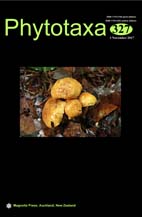Abstract
A new diatom species, Sellaphora constrictum sp. nov., is reported from a karst landform in the Maolan Nature Reserve, Guizhou Province, China. Valves of the new species are broadly linear, slightly constricted in the middle part of the margins and have round apices, an undulate filiform to lateral raphe, a narrow axial area and a narrow conopeum bordering axial area on each side. This species also has undulate ridges along the margin and near the center of the valve, giving the impression of longitudinal ridges on either side of the axial area under light microscopy. Internally, a round opening is present in the apex of the valve, and thickened transverse bars are absent in this region. There are two types of areolae on the valve exterior. Together these features distinguish the new species from all others currently assigned to the genus. We discuss the growing number of new species and genera from freshwater environments in China, and interpretations about the delineation of the genus Sellaphora.

